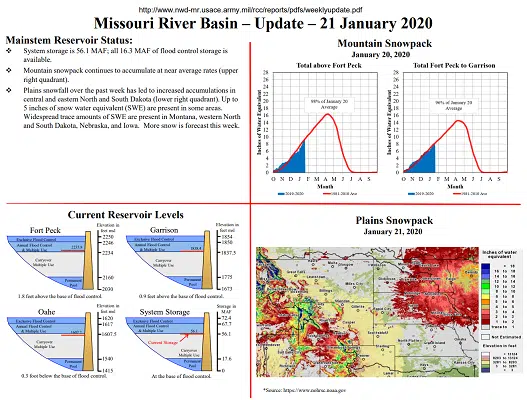The US Army Corps of Engineers will reduce releases from Gavins Point Dam at Yankton to 27,000 cubic feet per second tomorrow (Jan. 22).
Since increasing releases to 30,000 cfs Jan. 7, the pool elevation has dropped about six feet to 1201.9 feet.
Chief of the Missouri River Water Management Division John Remus says the pool level fluctuations at Gavins Point Dam have led to concerns that the lower pool level may affect access to water at some municipal water intakes on Lewis and Clark Lake.
All 16.3 MAF of flood control storage in the upper Missouri River dam system is available to capture and manage the 2020 upper Missouri River basin runoff.
However, Remus says while system storage has reached the base of the Annual Flood Control and Multiple Use zones, the reservoirs at Fort Peck and Garrison Dams still have water in their respective flood control pools. He says ice conditions on the Missouri River in North Dakota and Montana will limit the ability to empty the flood control pools at Fort Peck and Garrison Dams before March 1.
Mountain snowpack continues to accumulate and is currently at or slightly below average. The mountain snowpack accumulation period is about 50% complete and normally peaks around April 15.
Remus says releases from all projects– including Lake Oahe which is scheduled to release 28,500 cfs through Friday— will be higher than average during the remainder of the winter. He says the Corps will continue to monitor conditions and remain aggressive with releases, to the extent it is practicable. Additional precipitation, runoff conditions, river ice conditions or other circumstances could require additional adjustments to the reservoir release rates.
The mountain snowpack graphics can be viewed here: https://go.usa.gov/xE6wT.
The river ice report is available here: https://go.usa.gov/xpZZX.
Weekly updates on basin conditions, reservoir levels and other topics of interest can be viewed here: https://go.usa.gov/xE6wa.
The three-week forecast is updated each Wednesday, or more frequently as needed, and is available here: http://go.usa.gov/xVgWr.







